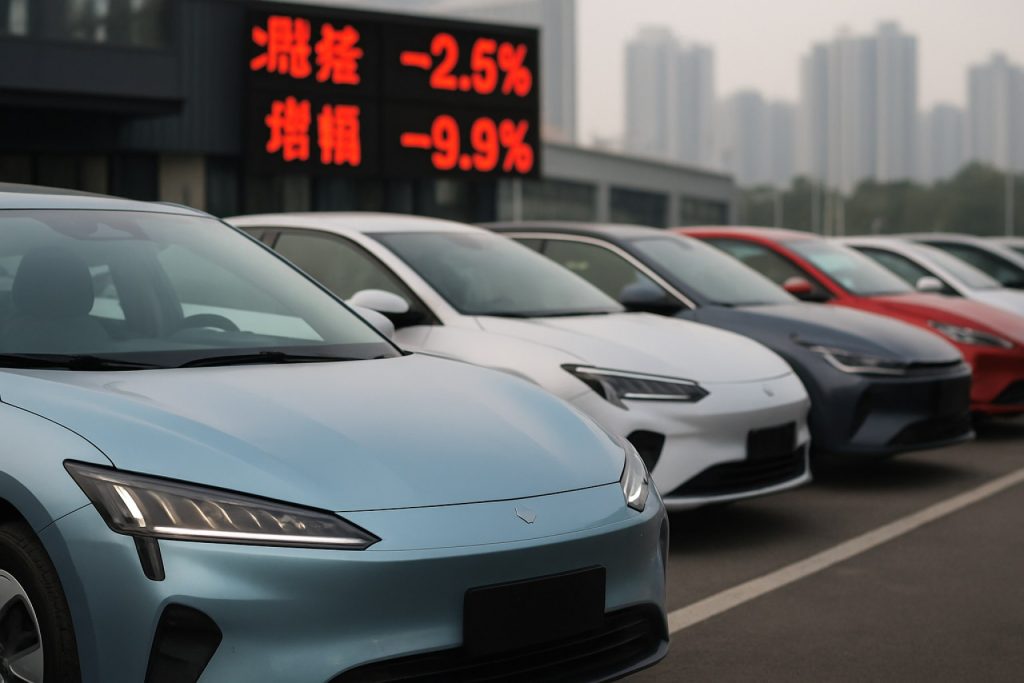
- China’s electric vehicle (EV) market is experiencing an intense price war, highlighted by BYD’s dramatic price cuts and the launch of its affordable Seagull model.
- Rival automakers like Changan and Leapmotor are matching price reductions, fueling industry-wide consolidation and turmoil.
- BYD’s aggressive moves triggered significant stock market reactions, with major share price drops reflecting investor concerns.
- The Chinese government is increasingly worried about destabilizing effects, including shrinking profits and possible bankruptcies among smaller automakers.
- With over 9 million EVs sold in 2023—a 32% yearly leap—China now shapes global competition in the electric mobility sector.
- The evolving auto landscape could see a handful of dominant national champions emerge to influence global transportation trends.
A cold wind swept through the corridors of China’s auto industry this week. The world’s largest electric vehicle (EV) battleground is witnessing a clash that could reshape global transportation—and it all starts with a hatchback named Seagull.
BYD, an emblem of China’s green ambitions and an automaker that recently outran Tesla in European sales, has ignited a fresh wave in the nation’s relentless price war. Over the weekend, the company slashed sticker prices across more than 20 models, offering the feisty battery-powered Seagull for as little as $7,770—a provocative invitation for millions of drivers to leap into EV ownership.
Not to be outdone, rivals like Changan and Leapmotor fired back almost instantly, launching their own price cuts in rapid succession. The stock market responded with a sharp twist. BYD’s Hong Kong-listed shares, buoyant just days earlier after a record-breaking performance, plummeted by nearly 9 percent in a single session. Shareholders reeled; industry observers braced for aftershocks.
The consequences ripple far beyond showroom floors. In the fierce laboratory of China’s auto industry, every price cut sends fresh tremors. BYD’s stature grants it immense sway—when it slashes prices, competitors scramble. The industry, already racing to survive cutthroat margins, faces a bloodletting pace of consolidation. Smaller automakers teeter on the edge while the giants muscle for dominance.
Yet the stakes rise higher still. The Chinese government, keenly aware of the dangers lurking beneath this “rat race,” has signaled concern. Economic planners warn that the price war could trigger instability, squeezing profits and accelerating bankruptcies. For global investors, this is a high-stakes drama: the companies that emerge victorious from this bruising contest won’t just dominate China, they’ll shape the future of electric mobility worldwide.
Meanwhile, the numbers stagger. China’s EV market, already the world’s largest, saw sales soar past 9 million units in 2023—a 32% surge from the previous year. Brands like BYD, SAIC, and Geely jostle for position in a sector now closely watched by regulators, investors, and environmentalists alike.
In these feverish maneuvers, a broader narrative unfolds. China’s new push to consolidate its fragmented financial sector—creating powerful banks and brokerages that can weather global shocks—parallels the automotive consolidation. As some familiar names fade from the streets, a handful of national champions could arise, capable of challenging even the likes of JPMorgan or Tesla on the world stage.
Therein lies the real lesson: competition, unchecked, breeds innovation but also peril. Price wars may thrill consumers and temporarily disrupt global markets, but the last car standing will be one with deep pockets, formidable scale, and relentless ingenuity. For now, China’s drivers cheer the discounts—but tomorrow, the map of the world’s auto industry may look very different.
Takeaway: In the battle to electrify the roads, survival will not go to the cheapest or even the flashiest, but to the most resilient. As prices tumble and companies merge, keep your eyes not only on what’s being sold today, but on who rises from the chaos to define the cars of tomorrow.
How China’s EV Price War Could Upend the Global Auto Industry (And What You Should Watch Next)
China’s EV Showdown: Beyond the Headlines
China’s escalating electric vehicle (EV) price war has sparked shockwaves that reach far beyond its own automotive market. While BYD’s headline-grabbing move to slash prices — offering its Seagull EV from just $7,770 — dominates current news, the story is deeper, with lasting ramifications for global transportation, EV technology, and even market stability. Here’s what you need to know — and what traditional reports missed.
—
1. How-To: Navigating China’s EV Market as a Consumer
– Compare Models: Even outside China, global buyers eye BYD, Leapmotor, Changan, and Geely for upcoming affordable models as exports increase.
– Follow Official EV Launches: Sites like Tesla or BYD’s global portal regularly update on international availability, specs, and market entries.
– Join Eco-Incentive Programs: Many local governments offer new subsidies for EV imports due to dropping purchase prices. Research your region’s green mobility incentives.
—
2. Life Hacks: Cheaper EVs, More Choices
– Affordable Urban Driving: At ~$7,770, the BYD Seagull is now more affordable than many used gas cars, making electric urban commuting vastly accessible.
– Lower Operating Costs: Chinese city planners note that total cost of ownership (TCO) for these EVs can be 30-50% less than midrange ICE models (according to International Energy Agency data, 2023).
—
3. Real-World Use Cases
– Regional Growth: Southeast Asia and Latin American importers are negotiating bulk procurement of Chinese EVs as affordable solutions to outdated taxi fleets.
– EU/US Disruption: As Chinese EVs become export-ready, European and American automakers face urgent pressure to lower prices or offer improved features to remain competitive (Bloomberg NEF, 2024).
—
4. Market Forecasts & Trends
– Intense Consolidation: Goldman Sachs predicts half of China’s near-100 EV makers could vanish in the next 3 years, with industry “giants” dominating remaining market share by 2027.
– Export Tsunami: China shipped more than 1.2 million EVs abroad in 2023 (China Passenger Car Association), a figure projected to double by 2025 as price points fall.
– Tech Leapfrogging: Expect rapid component innovation (solid-state batteries, LFP chemistry, “smart cockpit” infotainment) as firms try to differentiate beyond price.
—
5. Features, Specs & Pricing: The Value Equation
BYD Seagull:
– Range: ~305-405 km (CLTC cycle)
– Power: ~75hp motor; 0-50 km/h in 4.9s
– Safety: Basic ADAS (Automatic Emergency Braking in premium trims)
– Pricing: $7,770 (starter), up to $11,000 (top trims)
Comparison:
– Leapmotor T03 is similar in price, boasts a ~403 km range, but lacks BYD’s reliability reputation.
– Changan Lumin and Wuling Mini EV are cheaper but have less range and fewer safety features.
—
6. Controversies & Limitations
– Profit Warnings: Major consultancies (e.g., McKinsey) warn that razor-thin profits risk R&D investment, possibly stalling long-term innovation.
– Government Interventions: Chinese regulators signaled both support for “orderly competition” and readiness to step in if instability threatens jobs or financial stability.
– Quality Concerns: Not all discount EVs are created equal — some small city EVs have faced recalls over battery safety or software bugs, especially from underfunded companies.
—
7. Security & Sustainability
– Battery Recycling Push: Chinese government mandates on battery recycling have created the world’s largest closed-loop EV battery ecosystem, helping offset environmental concerns as more cars reach end-of-life (source: World Economic Forum).
– Cybersecurity: As EVs add connectivity, Chinese automakers are rapidly boosting investment in car data privacy following recent state guidelines.
—
8. Pros & Cons Overview
Pros:
– Incredible value-for-money for entry-level EVs
– Accelerated global EV adoption
– Innovation boost (charging, battery tech)
Cons:
– Market instability, risk of bankruptcies
– Quality risks from smaller firms
– Potential R&D slowdown
—
9. Most Pressing Reader Questions Answered
Will these cheaper EVs reach the U.S. or Europe soon?
– Likely, but most will first target developing markets where regulatory barriers are lower. BYD and Chery are already exporting to Southeast Asia and South America. Europe’s tariffs and safety standards may delay mass adoption until late 2024 or 2025.
Are price wars good for consumers long-term?
– Short-term, yes: better deals and rapid innovation. Long-term, industry consolidation could limit future choices and impact service/parts support as weaker brands exit.
Which brands are safest to trust?
– Stick with major players (BYD, Geely, SAIC) with established global service networks and proven safety records.
—
10. Actionable Recommendations & Quick Tips
– Watch Export News: Stay updated on which Chinese brands are entering your market.
– Research Incentives: Combine local tax credits with EV discounts for massive savings.
– Check Charging Compatibility: Ensure any imported EV supports your region’s charging standards (Type 2/CCS in Europe/U.S.).
– Read User Reviews: Platforms like Car and Driver, Electrek, and InsideEVs often feature early reviews or user reports for new Chinese EVs.
—
11. Industry Insights & Predictions
– Expect Chinese EV makers to aggressively grow market share outside China, forcing prices down everywhere.
– Legacy automakers will accelerate digitalization, electrification, and partnerships with tech firms or battery suppliers to keep up.
– As consolidation continues, “survival of the fittest” means only the most capitalized, tech-savvy automakers will thrive — echoing similar patterns seen in the early days of the U.S. auto industry.
—
Closing Thought
The current EV price war is a double-edged sword: it democratizes green technology but also tests the strength of even the most established manufacturers. If you’re interested in sustainable transportation, now’s the perfect time to educate yourself — and, perhaps, prepare for the day when a feature-packed, affordable electric car from China parks in your driveway.
For more auto and financial insights, explore the latest at JPMorgan and Tesla.



